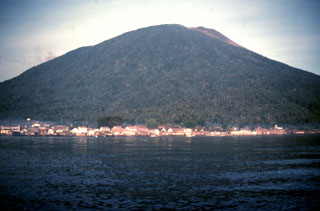Report on Gamalama (Indonesia) — May 1994
Bulletin of the Global Volcanism Network, vol. 19, no. 5 (May 1994)
Managing Editor: Richard Wunderman.
Gamalama (Indonesia) Update on continuing eruptions and seismicity
Please cite this report as:
Global Volcanism Program, 1994. Report on Gamalama (Indonesia) (Wunderman, R., ed.). Bulletin of the Global Volcanism Network, 19:5. Smithsonian Institution. https://doi.org/10.5479/si.GVP.BGVN199405-268060
Gamalama
Indonesia
0.81°N, 127.3322°E; summit elev. 1714 m
All times are local (unless otherwise noted)
Following its May 1993 eruption . . . activity remained high. An explosion in January 1994 at the main crater produced a dark ash cloud 750-1,000 m tall. Small gas explosions were common during February 1994, they often rose 200-400 m above the crater. One or more ash eruptions took place 25-27 March, dusting the village of Rua on the volcano's eastern slopes with thin ash.
Tectonic earthquakes were numerous, especially following the Halmahera earthquake of 21 January, 1994. Prior to the earthquake there were typically 10-25 events/day, following it there were 40 events/day. Volcanic earthquakes remained at normal levels, 3-5 events/day.
Geological Summary. Gamalama is a near-conical stratovolcano that comprises the entire island of Ternate off the western coast of Halmahera, and is one of Indonesia's most active volcanoes. The island was a major regional center in the Portuguese and Dutch spice trade for several centuries, which contributed to the extensive documentation of activity. Three cones, progressively younger to the north, form the summit. Several maars and vents define a rift zone, parallel to the Halmahera island arc, that cuts the volcano; the S-flank Ngade maar formed after about 14,500–13,000 cal. BP (Faral et al., 2022). Eruptions, recorded frequently since the 16th century, typically originated from the summit craters, although flank eruptions have occurred in 1763, 1770, 1775, and 1962-63.
Information Contacts: W. Tjetjep, VSI; BOM Darwin, Australia; S. Matthews, Univ of Bristol; UPI; Antara News Agency.

